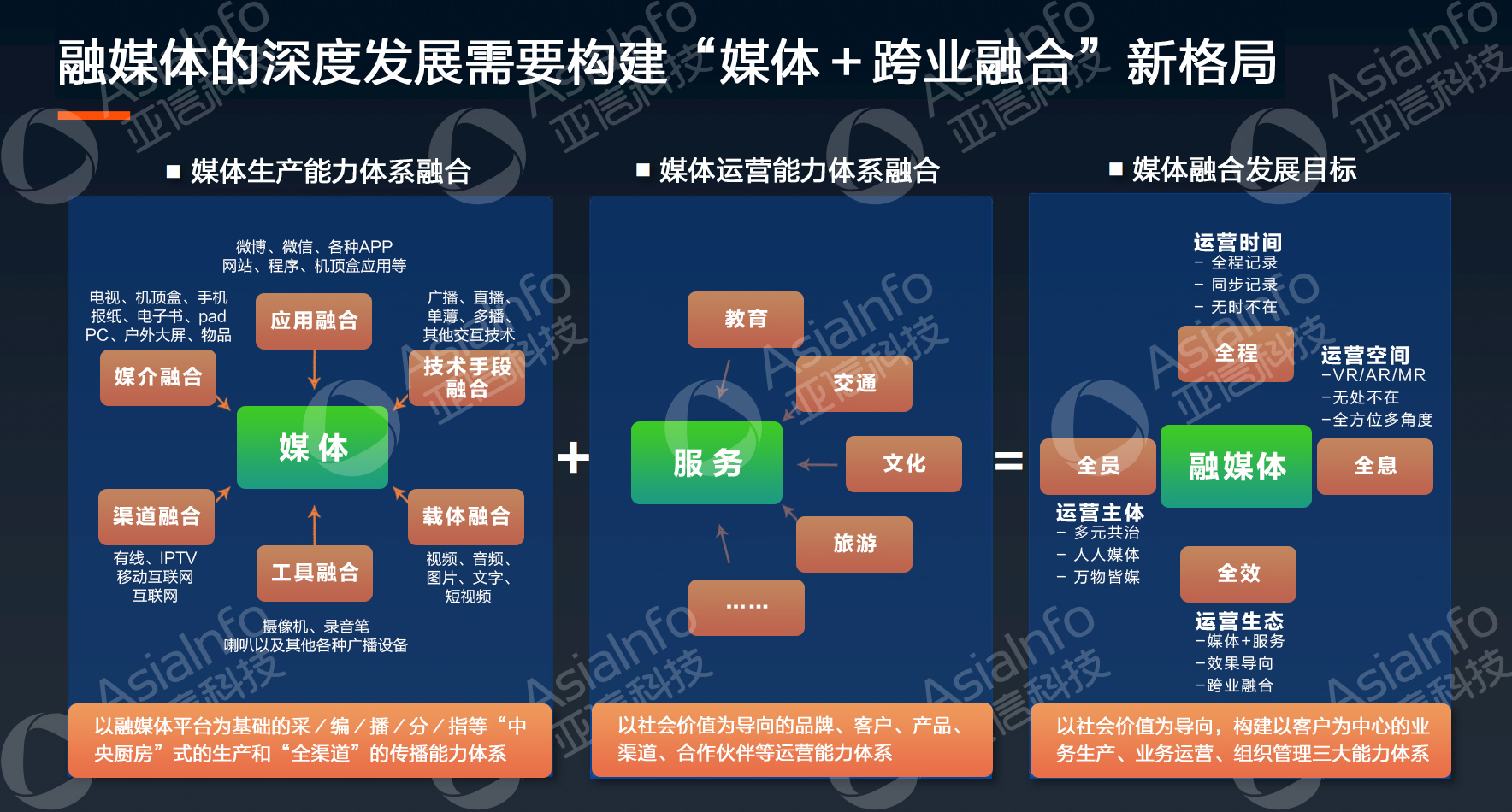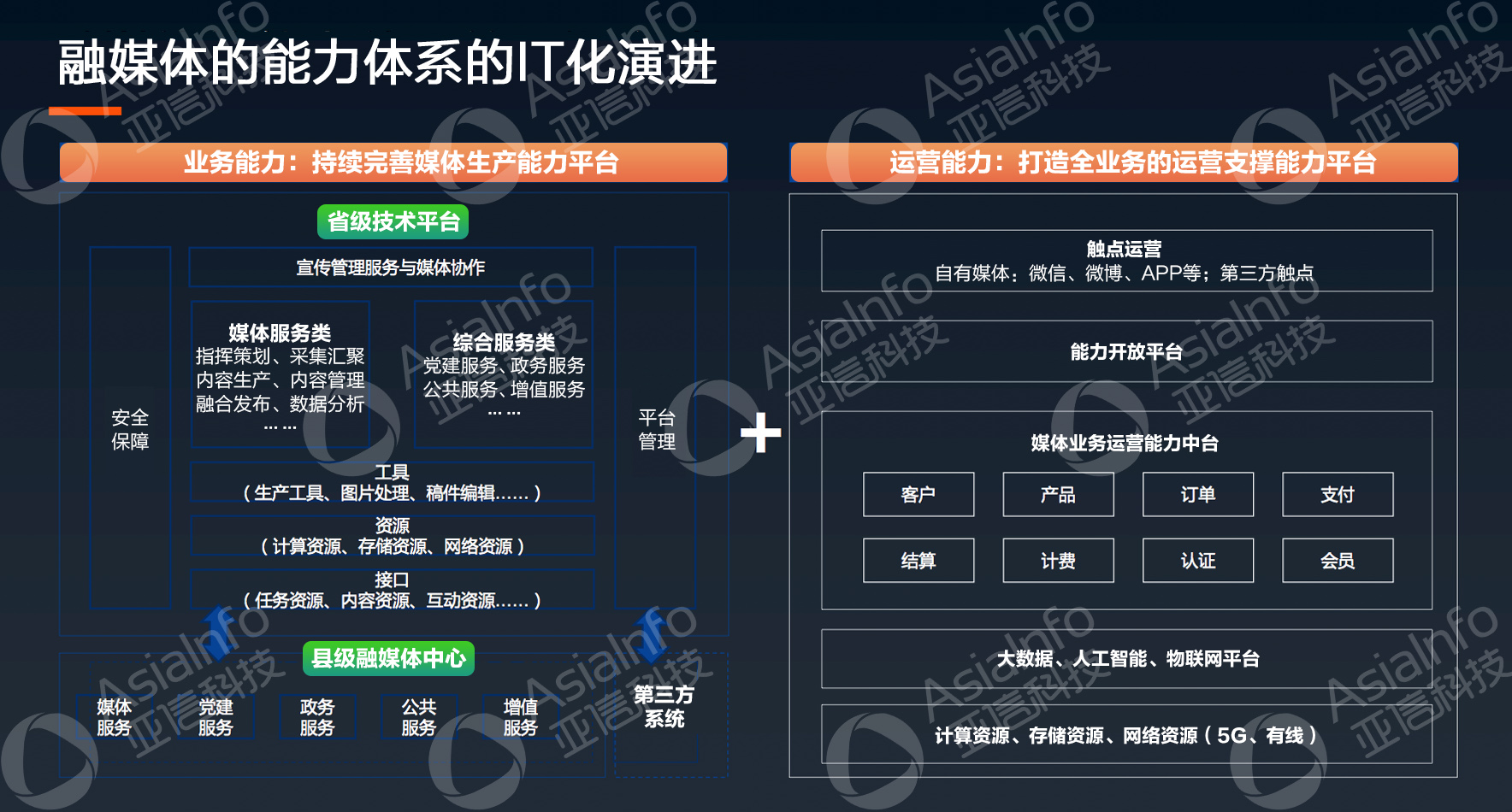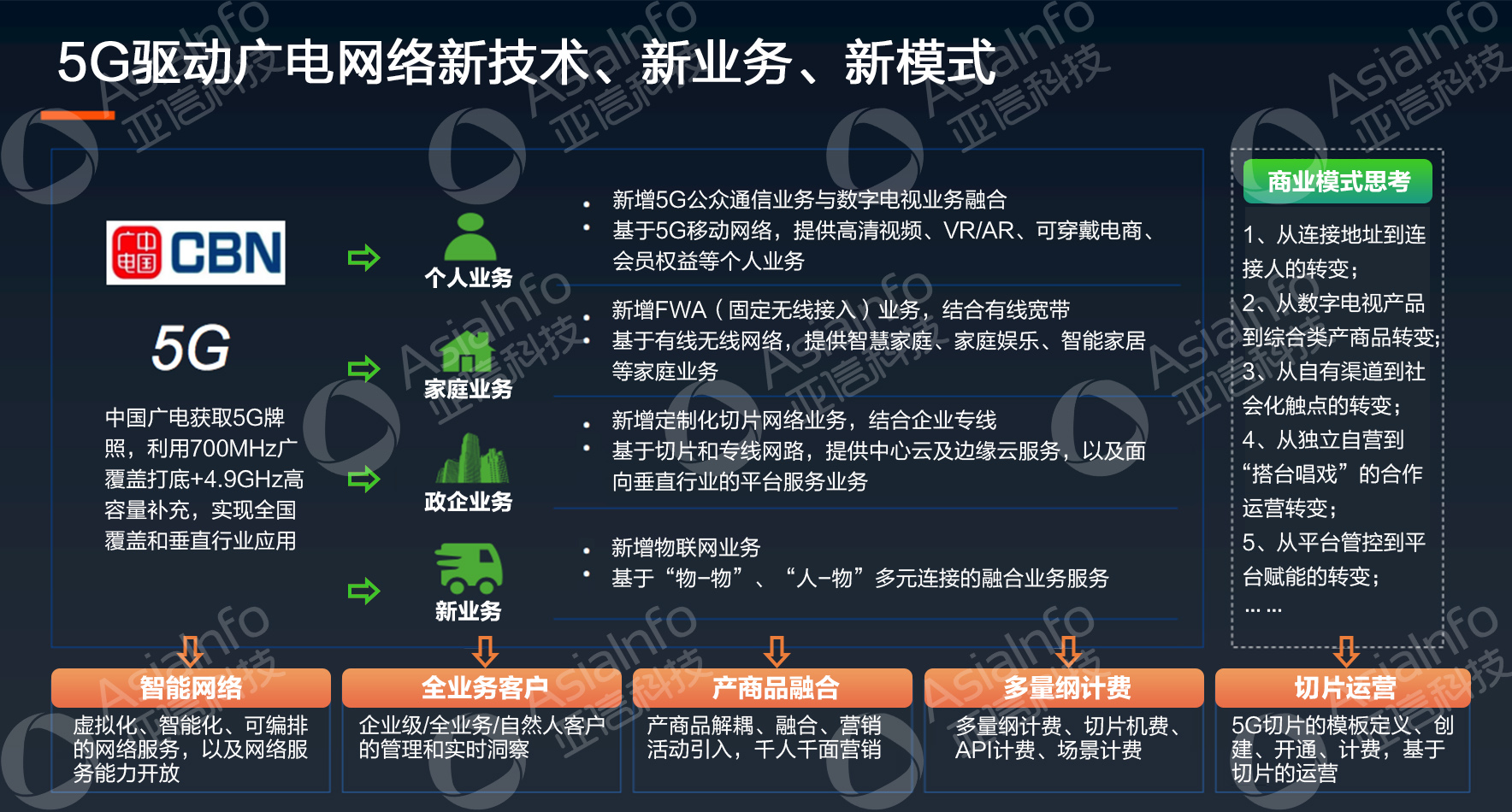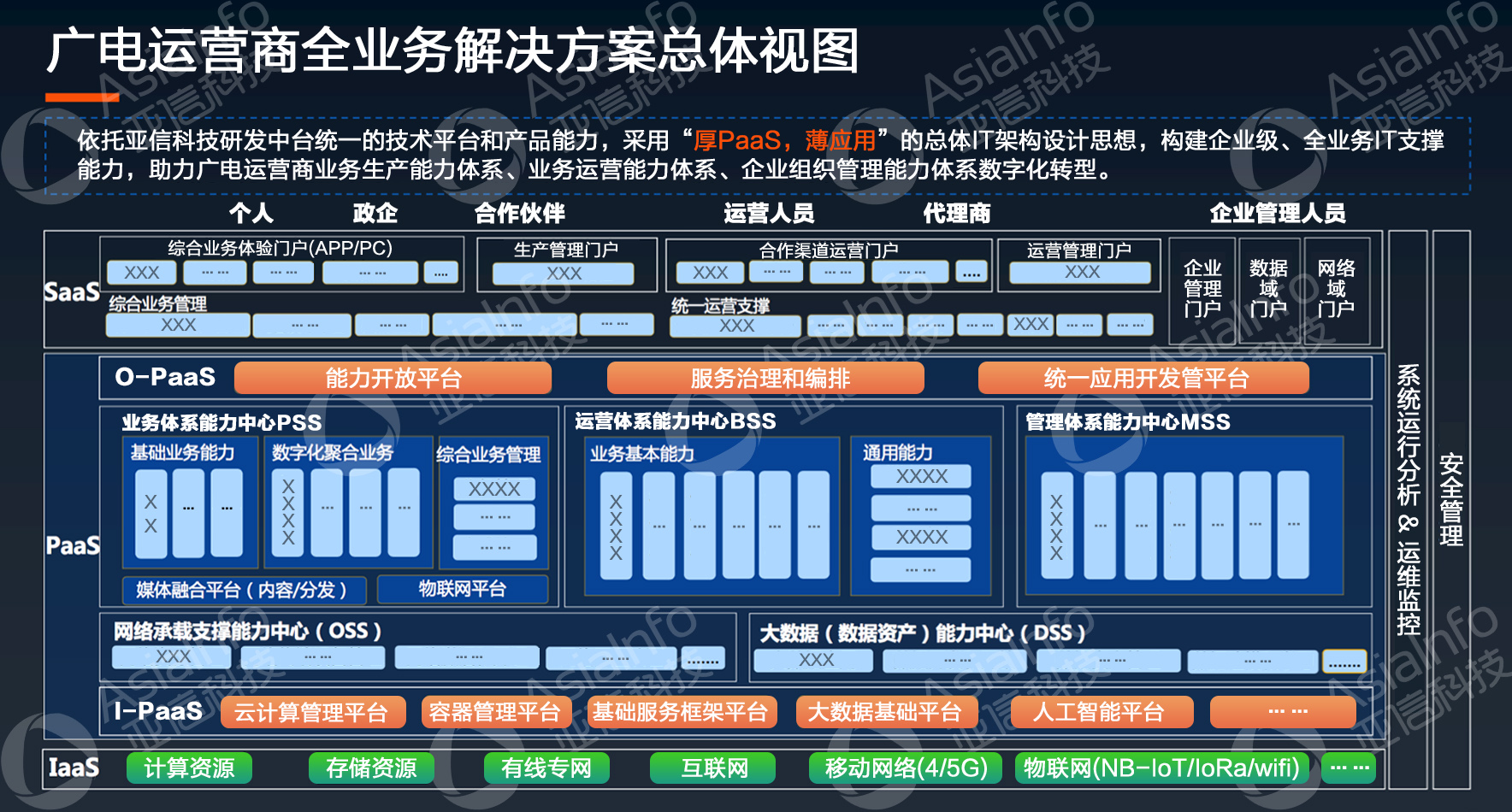Recently, the BIRTV China Radio and Television 5G Conference was held online. Leaders of relevant departments, industry experts and executives of companies gathered together to make a deep insight into the radio and television business operation planning in the 5G era and the promotion of the application and development of “5G + radio and television”. Dr. Li Hui, Vice President of AsiaInfo, was invited to attend the conference and delivered a wonderful speech entitled “Enabling 5G New Operations to Help Digital Transformation of Radio and Television”.
The speech is divided into three parts:
1. 5G network technology promotes the rapid development of digital economy;
2. Media convergence and 5G jointly create the new infrastructure for the radio and television industry;
3. AsiaInfo’s global products help the digital transformation of the radio and television industry.
The following are details.
Looking back at human history, the large-scale popularization of each key technology would bring major changes to the economy and society, for example, the widespread use of coal and electricity has ushered in the industrial age, and computers and the Internet have brought us into the information age. Now, the 5G will also start a “new era of intelligence” which connects everything and witnesses the explosion of innovation.
5G network technology promotes the rapid development of digital economy
In the face of the new era, favorable policies to promote the all-round development of the 5G industry have been continuously introduced. On June 6, 2019, four operators, China Telecom, China Mobile, China Unicom and CBN, were awarded 5G commercial licenses. In November of the same year, the relevant departments pointed out that breakthroughs would be made in 2022 among a number of key 5G technologies for the specific needs of the industrial Internet. In March 2020, speeding up the construction of new infrastructure was put forward again, with 5G ranking first in the “new infrastructure”. Subsequently, relevant departments emphasized the need to accelerate the deployment of 5G network construction, enrich 5G technology application scenarios, enhance the research and development of 5G technology, and build a 5G security system. On May 22, “Expanding 5G Applications” appeared again in the investment and construction of “Two New and One Major (new infrastructure construction, new urbanization construction, major projects of transportation, water conservancy, etc.)”.
5G has set a new development direction for various vertical industries, including the radio and television industry, and has become a new driver of economic and social development in the industrial Internet age.
Lately, the “White Paper on Digital Economy Development in China (2020)” issued by the China Academy of Information and Communications Technology indicates the importance of 5G network in the development of national digital economy in the future. The scale of China’s digital economy in 2019 has already accounted for 36.2% of GDP. Among the three elements supporting the development of the digital economy, the first is the massive data; the second is digital carriers, such as 5G network; and the third is digital technologies including big data, artificial intelligence, cloud computing, the Internet of Things, and blockchain, etc. The “digital carrier” is the core of the three elements. In the future, we will use the 5G network with the characteristics of “enhanced mobile broadband, high reliability and low latency, and massive machine communication” as the carrier, supported by ICT convergence technology, to promote industrial integration and boost the development of digital economy.
So, how can 5G network technology help the digital transformation of the industry?
First of all, it will give birth to new business models. 5G will promote the transformation of enterprises from mere product manufacturers to “customer operators” who can perceive and recognize consumers in a timely manner, which makes “digital operations” essential. At the same time, with the emergence of platform-based enterprises, the value of data will also be further dug to become a new momentum for social development just like hydropower and coal.
Secondly, it will lead to industry collaboration and win-win. On the one hand, 5G communication connects industries, such as finance, manufacturing, education, etc., and on the other hand, it connects customers. This closed-loop connection and management is conducive to understand customers in a timely manner and contributes to the improvement of the operating capabilities and market competitiveness of enterprises. Besides, 5G will also create an ecology-oriented business form that will help provide customers with integrated solutions; at the same time, it will also impel the openness of data assets, cloud-network collaboration, and ICT technology resource sharing.
The application level of 5G technology will probably become an important measure of the digital transformation of vertical industries.
Media convergence and 5G jointly create a new infrastructure for the radio and television industry
“Smart Radio and Television Strategy” is highly consistent with the development requirements of digital transformation, and runs through the entire industrial chain of the radio and television industry. With the coordinated development of county-level convergence media and provincial cloud platforms, CBN’s obtaining of 5G licenses, and the mature application of digital technologies such as 5G, big data, cloud computing, artificial intelligence, Internet of Things and blockchain, the entire industry chain of the radio and television industry will enter the fast lane of digital transformation of the industry. Especially at the media and network level - the convergence media evolves into “smart media”; 5G network of radio and television evolves into coordinated development of wireless + wired+ satellite integration. Local media organizations at province level, as well as national radio and television and provincial network companies, have become the main driving force and leader in the industrial digital transformation.
In the tide of digital transformation across the country, what measures should the radio and television industry take? In the long-term practice of transformation, we have concluded that the following five questions need to be considered and resolved by the entire industry:
1. What is the market driving force for transformation? The vigorous digital economy contains huge consumption potential, which is the economic value driver for the in-depth development of convergence media and the integrated development of 5G wireless and wired network of radio and television, and the fundamental driver for enterprise transformation. That is, “finding values”;
2. What is the theoretical support for transformation? 5G is productivity. Optimizing and reshaping production relations to adapt to the development of productivity is the theoretical basis of the digital transformation of enterprises. The production and operation process, management system and business process of an enterprise all belong to the concept of production relations. Taking advantage of the current rapid development of digital technology, the production relations during transformation can be straightened out, which reflects the basic realization path of digital transformation. That is, “finding a way”;
3. How to make up for the deficiency of technical capability? For many companies, it is not easy to to achieve the same technical level in terms of 5G, big data, cloud computing, Internet of Things, artificial intelligence and other digital technologies overnight, and the cost of infrastructure investment is also a huge challenge. This is also the starting point for China to vigorously promote “new infrastructure” in order to quickly empower the industry and promote the digital transformation and development. For the radio and television industry, the cloud platform of convergence media and integrated development of 5G wireless and wired network of radio and television technically belong to the “new infrastructure projects” of radio and television industry, i.e. “promoting infrastructure”;
4. What will the innovative business model bring? It will not only bring new customer operation methods, product empowerment and platform-based development, but require a new type of partnership among provinces, cities and counties, as well as between state-owned enterprises and private enterprises to be formed from the perspective of the entire industry. That is, “forming an ecology”;
5. Digital talents. Digital transformation needs to pay attention to the cultivation of various talents for technology, management and strategic planning to realize “strengthen talents”.
Traditional infrastructure supports the industrial ecology of the traditional real economy, while new infrastructure supports the industrial ecology of the digital economy. The realization of digitalization in the radio and television industry needs to be driven by the dual engines of “media convergence” and “integrated development of 5G wireless/wired network of radio and television”.
About media convergence
As the development of convergence media has entered the stage of in-depth development, a new pattern of “media + cross-industry convergence” is urgently needed. At the present stage, the “central kitchen” type of production and the “omni-channel” dissemination capability system of acquisition/editing/broadcasting/distribution/referring based on the convergence media platforms have been continuously improved, which has constantly strengthened the business production capacity of the convergence media. “Increase customer stickiness, meet comprehensive needs of customers, and retain customers” has become a key capability requirement for the further development of convergence media. Currently, it has become a capability building trend in the convergence media development to construct a new “media+” pattern combining media and education, transportation, culture and tourism, life services and other related industries in order to form a new operating capability system that connects brands, customers, products and channels and covers the basic necessities of customers. The integration of the media production capacity system and the innovation of the operating capability system will contribute to create the “media involving the whole course, multiple information format, all types of subjects and comprehensive effects”, and ultimately form three capability systems for business production, business operation and organization management that are social value-oriented and customer demand-oriented.

In terms of business production capacity, a collaboration capability system for multi-level convergence media business production should be built at the central, provincial, and municipal levels in accordance with the nationally planned media convergence policies: Provincial centers should provide media content production tools to build a “central kitchen” to empower district and county media; district and county media should build media service capabilities based on the “central kitchen” and apply them to the individual, government and corporate markets.
In terms of business operating capability, AsiaInfo believes that the radio and television industry needs to construct a “full-service operating support capability platform of convergence media”. It contains the computing, storage and network resources in the bottom layer, big data and the Internet of Things platform assisted by artificial intelligence technology in the second layer, and the middle-ground of media business operating capability built to adapt to the development of convergence media and 5G in the third layer (providing capabilities of customer management, product, order, payment, etc.). A capability opening platform will be built on the middle-ground, thereby extending the operating points to WeChat, Weibo, APP and other channels, so that the operating system can reach all customers. This is the goal of the current IT evolution of the convergence media capability system, and it is the core technology, product and service advantages of AsiaInfo.

About radio and television network
The changes brought by 5G to the radio and television network are mainly reflected in the birth of new technologies, new services and new models. CBN can make use of 700MHz wide coverage as a base and 4.9GHz as a high-capacity supplement to achieve national coverage and key applications in vertical industries of 5G network, which effectively supports personal radio and television services, household services, government and corporate services and the development of new-born Internet of Things and convergence businesses under 5G network.

The business model changes brought about by 5G will be reflected in:
1. The radio and television network will change from linking addresses (such as households) to linking a wider range of natural persons;
2. The mere sales of digital TV products will be changed into overall selling of comprehensive products and commodities;
3. Commercial channels will expand from owned channels to more social touchpoints;
4. Radio and television will evolve from independent and proprietary business to cooperative operation;
5. The media will change from a management and control platform to an “enabling platform”;
...
The above-mentioned changes in business forms and business models are based on the solid foundation laid by the application of 5G and other new technologies, and have brought new requirements and challenges to the network operation capability and business operation support of the radio and television network. This is reflected in: Network intelligence, full-service customers, product and commodity integration, multi-dimensional billing, slicing operations and other key aspects. 5G shapes an intelligent network which can provide virtualized, intelligent and orchestrated network services. The opening of intelligent network capabilities is critical to the development of 5G applications. 5G will also enrich the radio and television customers, and will develop from traditional family customers to full-service customers including individuals, families and enterprises, and can form real-time insights into customers based on the network. The decoupling of the existing platform system of radio and television will also accelerate the pace of product and commodity integration, and will also realize different intelligent marketing with the introduction of more and more marketing activities. 5G will also give birth to multiple billing forms such as multi-dimensional billing, slicing billing, API billing and scene billing, which will promote 5G networks, applications and business to be more closely integrated, and such flexible and diverse billing methods are also convenient for the radio and television system to better serve customers. 5G has created “slicing operation”, in which the definition, creation, activation and billing of slicing templates are all automated without human intervention in order to ensure the smooth flow of 5G applications.
With the upcoming development of the 5G business of radio and television, the construction of a new generation of operation support system is imminent for CBN and provincial branches. AsiaInfo has nearly 30 years of experience in the communications field, and has an extraordinary understanding in operators’ businesses, which can play an important role in the construction of a new generation of 5G operation support system of radio and television in the future. We believe that the general principle is to form a two-tier structure of “CBN support platform + geological operation of provincial network companies”, to aggregate suppliers, service providers, ISVs, end customers and other ecological partners and create a platform-based business model by adhering to the cooperation principle of mutual benefit and sharing. In the future, the 5G business operation support system should be “agile in architecture, unified in management, ecological in business, Internet-based in experience, and intelligent in marketing”. In this regard, radio and television can innovate based on the roads of other operators to form a late-mover advantage.
AsiaInfo’s global products help the digital transformation of radio and television industry
In over 20 years of development process, AsiaInfo has fully participated in the IT system construction and business operation of the three major operators of China Telecom, China Mobile and China Unicom, forming a strong technical and operation support capability. The product research and development concept of “three global” (global virtualization, global intelligence, and global perceptibility) has been proposed to help CBN build a business middle-ground integrating B domain, O domain, and M domain to obtain cloud-network collaboration and intelligent operation capability in the 5G era.
In the specific implementation process, by relying on the capabilities of R&D middle-ground of AsiaInfo, the overall IT architecture design concept of “thick PaaS, thin application” has been adopted to build enterprise-level and full-service IT support capabilities, and form a “full-service solution of radio and television operators” to assist radio and television operators in promoting the all-round digital transformation of production capacity system, operating capability system, and corporate organization management system.
The solution is divided into three parts. The bottom layer is the IaaS capability, which connects resources of computing, storage and network; the upper layer is the PaaS layer. Based on self-developed cloud computing management platform, container management platform, big data and artificial intelligence, Asiainfo builds a network bearing support capability center and a big data capability center, and forms a business system capability center, an operation system capability center and a management system capability center on it, and then empowers front-end SaaS applications through the capability opening platform, service governance and orchestration, and unified application development management platform, in order to provide unified service support for individual/government and corporate customers, partners, operators, agents and corporate executives.

In the past two years, AsiaInfo has been deeply involved in the 5G construction of operators and has launched many competitive core products in big data, 5G billing, artificial intelligence, slicing operations, etc. The following are a few typical cases.
Case 1: In 2019, AsiaInfo helped a provincial company of a communications operator complete the construction of China’s first 5G SA (independent networking) billing project. This was also the first implementation case of 3GPP business support specifications in China. The system construction not only combined the SA networking strategy of China Mobile, but integrated the business capabilities of that province, which could flexibly support its 5G business development and empower 5G ecological operations.
Case 2: AsiaInfo supported a communications operator group to build a network-level 5G slicing management platform. The platform has been successfully commercialized to carry the 5G slicing needs of customers in the power, energy and transportation industries, and has realized the end-to-end orchestration and management of 5G slicing and 5G network elements to effectively assist the customer in enabling vertical industries.
Case 3: Based on AsiaInfo’s global artificial intelligence product AISWare AI², a communications operator built an artificial intelligence platform for the group and relied on the platform to access the voice, semantics, OCR and other special AI capabilities of third-party companies, realizing the unified access of a variety of special AI capabilities for different vendors; through unified data collection, storage, management, and sharing and opening, the entire process connection of AI capabilities, unified resource management and control and unified reasoning services have been realized to provide AI services for more than 30 provincial branches and professional companies across the country.
The above cases are just a drop in the bucket of many business practices of AsiaInfo. We hope to help the radio and television system build a new business operation capability in the 5G era and comprehensively promote the digital transformation of the industry on the basis of more than 20 years of accumulation in technology, product and solution.







